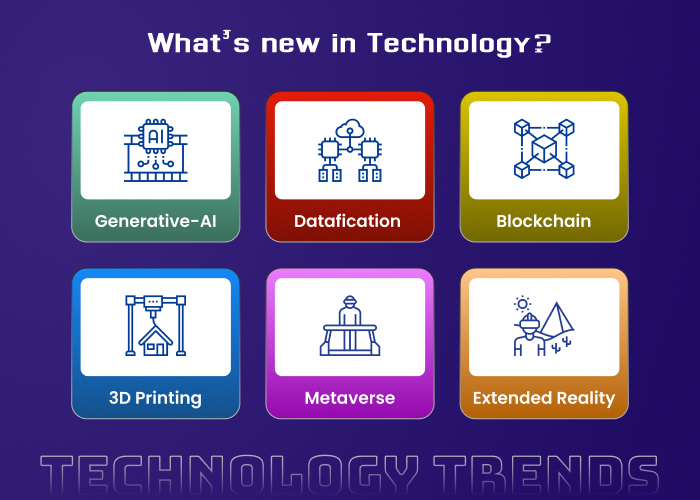What’s new in technology?

Which are the trending technologies? What are the latest technology trends? Here is the list of new technology that is in trend.
Generative-AI
Since it allows computers to create material that closely resembles that made by humans, the latest technology, generative AI, has changed several industries. Generative AI has created new opportunities for creativity and innovation in a variety of fields, including text production, picture creation, and even music composition. For those with the application skills necessary, this technology offers interesting job options as it develops.
Researchers in AI are essential to developing generative AI’s capabilities. They expand the frontiers of content creation through the development of complex models and algorithms. To produce outputs that are more varied and realistic, these researchers go further into fields like deep learning, neural networks, and reinforcement learning.
Data scientists find hidden trends, patterns, and correlations inside datasets by using methods including data mining, pattern recognition, and predictive analytics. Furthermore, Generative AI systems and technologies enable content makers to quickly and effectively create a wide variety of creative material.
Datafication
This new technology entails gathering, analyzing, and using data in order to comprehend and improve processes, systems, and decision-making. To put it simply, Datafication is the process of turning real-world occurrences into digital data that can be used for action, interpretation, and analysis.
Practical instances of Datafication include:
- Smart cities maximize urban infrastructure, increase public services, and improve transportation systems using data from sensors, IoT devices, and citizen interactions.
- E-commerce sites use user browsing patterns, past purchases, and preferences to tailor recommendations, improve pricing, and improve the overall buying experience.
- To enhance diagnosis, treatment, and the delivery of healthcare, healthcare organizations gather and examine patient data, electronic health records, and medical imaging.
Blockchain
Blockchain is a distributed, decentralized ledger system that maintains immutability, security, and transparency by recording transactions across several computers. This latest technology was first created as the foundational technology for cryptocurrencies like Bitcoin, but it has now expanded to find uses in a wide range of sectors outside of finance.
Self-executing contracts known as ‘smart contracts’ have the provisions of the contract encoded directly into the code. When certain requirements are satisfied, they automatically carry out and uphold contractual commitments.
Despite its potential, blockchain faces challenges related to scalability, interoperability, regulatory concerns, and energy consumption.
3D Printing
Additive manufacturing, also referred to as 3D printing, is a cutting-edge technology that makes it possible to construct three-dimensional items layer by layer from digital drawings.
While traditional subtractive manufacturing techniques entail drilling or cutting material out of a solid block, 3D printing creates items layer by layer, enabling customization and very complex geometries.
Quick design testing and iteration are made possible by 3D printing’s quick turnaround times, which also shorten the time it takes to develop new products. Because 3D printing eliminates material waste and tooling expenses, it can be more economical than traditional manufacturing procedures for short production runs or bespoke products.
Metaverse
Since it was first mentioned in a fiction book in 1992, you can’t say Metaverse is a new technology; but, given the constant advancements and revolution it is undergoing, it may be considered part of the newest technological trend.
It is a communal virtual environment that offers immersive experiences, social connections, and business prospects while blurring the lines between the actual world and the virtual one.
Users can communicate in real-time with digital things and with one other in the metaverse. These interactions are typically facilitated by avatars or virtual personas.
Users may collaborate on projects, participate in online events and activities, and have social interactions with the use of communication technologies including text chat, voice chat, and gestures.
Extended Reality
VR, AR, mixed reality, and all such technologies that resemble reality are together referred to as extended reality. We all want to flee the perceived actual bounds of the world, which makes it a huge technological trend at the moment.
This technology, which creates a reality without any physical presence, is extremely well-liked by gamers, retail, and modeling industries. In terms of extended reality, gaming is a key industry for well-liked jobs that only want an online gaming interest rather than advanced credentials.
Conclusion
As technology keeps developing at a breakneck speed, it is essential for people, companies, and society at large to keep up with the latest developments. In the upcoming years, the top new technology trends covered in this blog are expected to have a big influence on a lot of different businesses and fields.
Cutting-edge technologies like generative AI, Datafication, blockchain, 3D printing, metaverse, and extended reality are changing how we communicate, work, and live. These trends provide enormous prospects for development, efficiency, and change, from fostering creativity and invention to upending sectors like banking, healthcare, and entertainment.
FAQs
What are the ethical considerations associated with the use of generative AI in content creation?
How can blockchain technology be applied beyond cryptocurrencies and finance?
What are the environmental implications of the widespread adoption of 3D printing technology?
How will the metaverse impact traditional brick-and-mortar businesses?
What are the potential risks and benefits of extended reality in terms of human perception and interaction?
Ravi Bhojani is the Chief Marketing Officer (CMO) at Alian Software, where he spearheads the company’s marketing strategies and drives its brand presence in the competitive IT services landscape. With over a decade of experience in the technology and marketing sectors, Ravi has consistently demonstrated his ability to blend innovative marketing techniques with deep industry knowledge to deliver outstanding results.